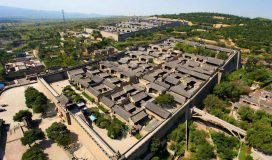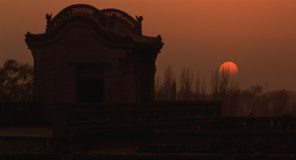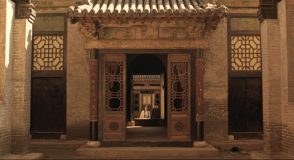RAISE THE RED LANTERN, DIR. ZHANG YIMOU (1991)
Qiao’s Mansion, Shanxi province, China
Raise The Red Lantern is the production of director Zhang Yimou.Adapted from Su Tong’s novel “The Wives and Concubines”, the film revolves around feudal rituals and tells the story of what happens in the mansion since Songlian marries into the family. It reflects the internal conflicts of the feudal family of polygamy.
The film was filmed in the Qiao’s mansion, located in Shanxi province, was built in 1756 and is divided into six courtyards with 313 houses in the shape of ‘囍’. The building is surrounded by a fully enclosed brick wall of over 10 metres. The Qiao’s mansion embodies the unique style of Chinese Qing Dynasty residential architecture and is an ancient house with a traditional northern residential architectural style.
In the film, all the scenes were shot in that big mansion, which is like a big cage. The film’s composition is axis-symmetrical primarily, with the compound of the Chen Mansion being shot in a square manner, the inside and outside of the house being neat and tidy, just like the invisible rules and regulations of the Chen Mansion, which are strict and untouchable, with power concentrated in the hands of the ruler, and the women and servants all serving the master.
The mansion is always an important character in the movie, a cultural image that omnipresently occupies the screen space. There are numerous symmetrical compositions, and the doors of the houses are layered in these fixed images.
The repetition of these closed courtyards from the same camera angle creates a sense of passage and change over time. The sky changes, the people change. The only thing that remains the same is this feudal cage and the pressure of confinement it brings.
The four colours, red, black, white, and blue, are used interchangeably in this film. Blue symbolises the ferocity and darkness of feudal society. Dark blue brick walls always enclose the large red lanterns, also revealing the theme of the work. That behind the so-called red happiness is the essence of being bound by the backward feudal ideology and that the vast number of oppressed women cannot ultimately escape their tragic fate. The composition, the overhead camera position forming a closed composition with the eaves connected, the use of long shots and fixed scenes, the subjective shots, the alternating use of close up and distant shots and the exaggerated contrasting techniques all give the film a suffocating feeling.
Symbolism is used throughout the film. The film captures the story of the year, but the season of spring is never present. The director perhaps wants to tell us that there is no spring for these women, that they live forever in a season of depression, without sunlight.
The courtyard is closed and quiet, life is dull and depressing. The film is full of the pathos of women and the old society. The red lanterns are lit night after night, and the gloomy sky never clears.
— Joran Zhang 3035836070

The high walls clearly divide the courtyard from the outside.


A total of 18 courtyard facades are shown in a closed ‘口’ shape.

The film makes good use of the roof of the Qiao family compound. The director has used more space to shape the environment and to express a sense of ‘cage’. Above, the third wife sings on the roof.

The “trap” formed by the courtyard door.
You have made detailed analyses of the visual aspects of the film in relation to the plot. Yet, it seems that your virtual field trip materials are limited. What does the mansion look like in reality? What is being altered in order to tell the story? You will be able to make another layer of comparison with this information. Moreover, you are encouraged to utilize concepts that are introduced in the class to anchor your points.